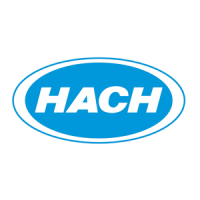44
SECTION 3, continued
3.2.4.2 Adding a Surfactant
Surfactants should be limited to severe problems when other degassing
methods are ineffective. This technique is very effective when the water
is super-saturated with air. Surfactants change the surface tension of the
water, which releases trapped gases.
1. Add one drop of a surfactant (Triton X-100, Cat. No. 14096-32 or
equivalent) to the sample cell.
2. Add sample.
Note: Any turbidity contributed by surfactant addition is negligible.
3. Mix the sample gently but thoroughly, and analyze as soon as
possible after adding the surfactant.
4. Rinse the sample cells thoroughly between samples to prevent
surfactant accumulation.
3.2.4.3 Using an Ultrasonic Bath
Ultrasonic baths effectively remove gas bubbles from most samples,
especially viscous liquids. However, the ultrasonic waves which cause
degassing may also alter the characteristics of the particles causing the
turbidity. Turbidity depends on the size, shape, composition and
1. Fill a sample cell to
the mark with sample.
Insert a #2 single-hole
rubber stopper and
syringe into the cell.
If using a pump, insert
a piece of glass tubing
into the stopper.
2. Slowly apply the
vacuum by carefully
pulling the plunger
upward, then holding it.
If using a hand or electric
pump, connect the tubing
to the vacuum pump with
vacuum hose. Apply
vacuum until visible gas
bubbles disappear.
3. Slowly release the
vacuum. Remove the
vacuum apparatus and
cap the cell.

